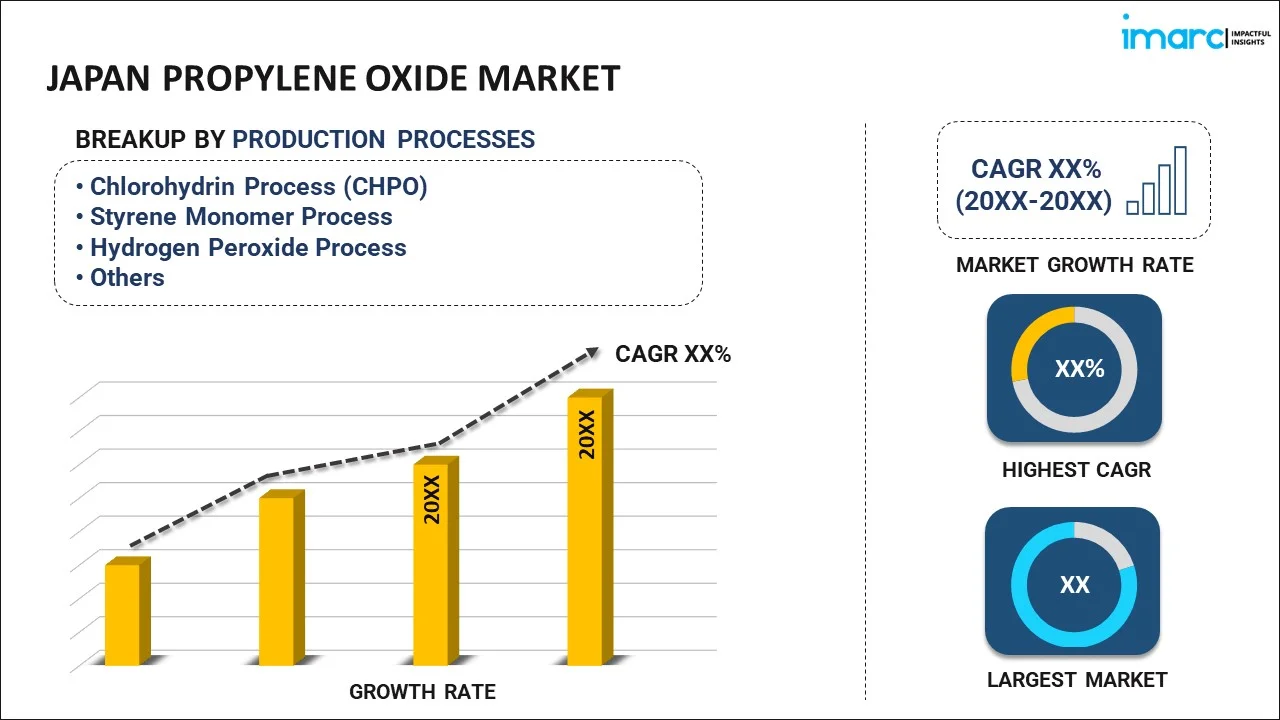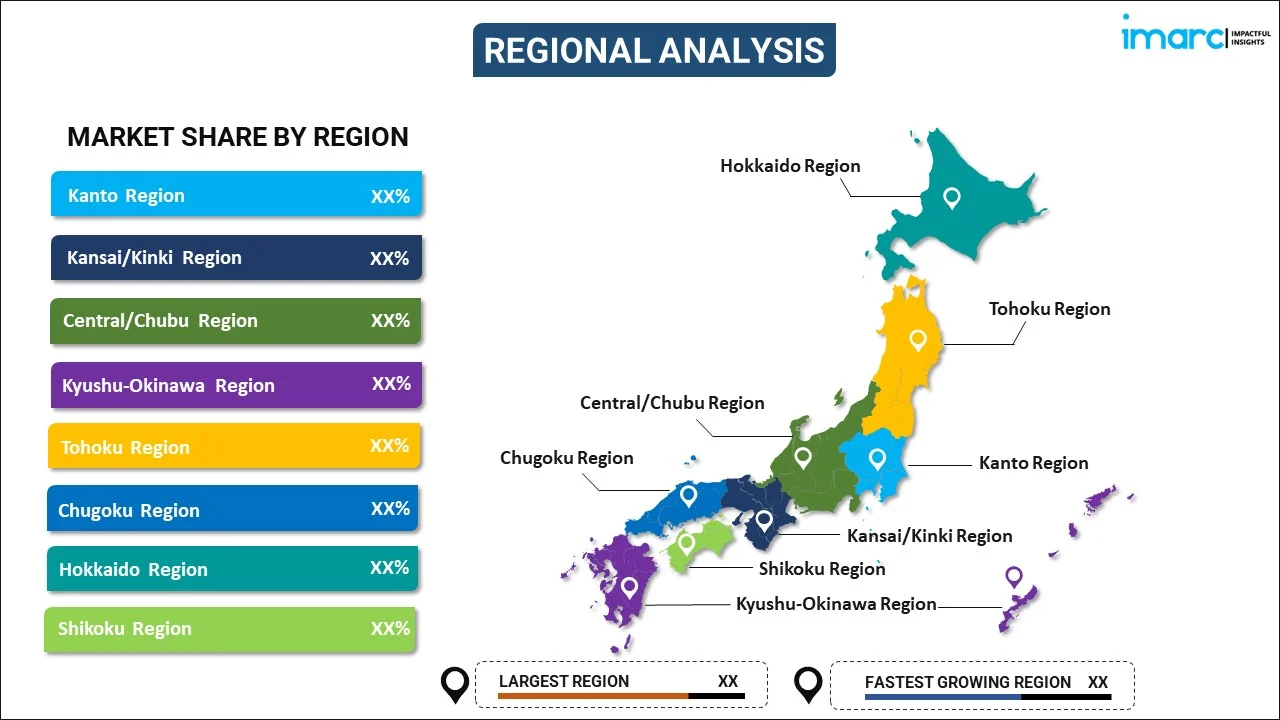
Japan Propylene Oxide Market Report by Production Process (Chlorohydrin Process (CHPO), Styrene Monomer Process, Hydrogen Peroxide Process, TBA Co-Product Process, Cumene-based Process), Application (Polyether Polyols, Propylene Glycols, Propylene Glycol Ethers (PGE), Polyalkylene Glycols, and Others), End Use Industry (Automotive, Construction, Chemicals and Pharmaceuticals, Packaging, Textile and Furnishing, and Others), and Region 2025-2033
Market Overview:
Japan propylene oxide market size reached USD 1.3 Billion in 2024. Looking forward, IMARC Group expects the market to reach USD 2.0 Billion by 2033, exhibiting a growth rate (CAGR) of 5.1% during 2025-2033. The increasing changes in consumer preferences and awareness of environmentally friendly products, which can influence the demand for goods that use propylene oxide in their production, is driving the market.
|
Report Attribute
|
Key Statistics
|
|---|---|
|
Base Year
|
2024 |
|
Forecast Years
|
2025-2033 |
|
Historical Years
|
2019-2024
|
| Market Size in 2024 | USD 1.3 Billion |
| Market Forecast in 2033 | USD 2.0 Billion |
| Market Growth Rate (2025-2033) | 5.1% |
Propylene oxide is a highly versatile organic compound with the chemical formula C3H6O. It is a colorless, flammable liquid that is widely used in various industrial applications. One of its primary uses is in the production of polyurethane plastics, where it serves as a key building block. Additionally, propylene oxide is utilized in the synthesis of propylene glycol, a common ingredient in numerous consumer products such as antifreeze, cosmetics, and pharmaceuticals. Its ability to undergo reactions with various chemicals makes it valuable in the manufacturing of other compounds and as a sterilizing agent for medical equipment. However, it is important to note that propylene oxide poses health and safety risks due to its flammability and potential toxicity, and thus, proper handling precautions are essential in its use and production. Overall, propylene oxide plays a crucial role in the chemical industry, contributing to the creation of numerous essential products in modern life.
Japan Propylene Oxide Market Trends:
The propylene oxide market in Japan is experiencing robust growth, driven by a confluence of factors that collectively shape its trajectory. Firstly, the increasing demand for polyurethanes in various industries, including construction and automotive, serves as a pivotal driver. This surge in demand is attributed to the versatile applications of polyurethanes, ranging from insulation materials to cushioning foams. Additionally, the escalating need for propylene glycol, a key derivative of propylene oxide, in the food and pharmaceutical industries acts as another driving force. This demand surge is underpinned by the growing awareness of the compound's hygroscopic and solvent properties. Furthermore, the regional focus on sustainable practices has spurred the demand for bio-based propylene oxide, reflecting a broader shift towards eco-friendly alternatives. The market dynamics are also influenced by the escalating automotive production in Japan, as propylene oxide finds extensive use in manufacturing automotive parts. Moreover, the consistent growth of the construction sector, along with the rising demand for propylene oxide-based products in adhesives, sealants, and coatings, is expected to drive the propylene oxide market in Japan during the forecast period.
Japan Propylene Oxide Market Segmentation:
IMARC Group provides an analysis of the key trends in each segment of the market, along with forecasts at the country level for 2025-2033. Our report has categorized the market based on production process, application, and end use industry.
Production Process Insights:

- Chlorohydrin Process (CHPO)
- Styrene Monomer Process
- Hydrogen Peroxide Process
- TBA Co-Product Process
- Cumene-based Process
The report has provided a detailed breakup and analysis of the market based on the production process. This includes chlorohydrin process (CHPO), styrene monomer process, hydrogen peroxide process, TBA co-product process, and cumene-based process.
Application Insights:
- Polyether Polyols
- Propylene Glycols
- Propylene Glycol Ethers (PGE)
- Polyalkylene Glycols
- Others
A detailed breakup and analysis of the market based on the application have also been provided in the report. This includes polyether polyols, propylene glycols, propylene glycol ethers (PGE), polyalkylene glycols, and others.
End Use Industry Insights:
- Automotive
- Construction
- Chemicals and Pharmaceuticals
- Packaging
- Textile and Furnishing
- Others
The report has provided a detailed breakup and analysis of the market based on the end use industry. This includes automotive, construction, chemicals and pharmaceuticals, packaging, textile and furnishing, and others.
Regional Insights:

- Kanto Region
- Kansai/Kinki Region
- Central/ Chubu Region
- Kyushu-Okinawa Region
- Tohoku Region
- Chugoku Region
- Hokkaido Region
- Shikoku Region
The report has also provided a comprehensive analysis of all the major regional markets, which include Kanto Region, Kansai/Kinki Region, Central/ Chubu Region, Kyushu-Okinawa Region, Tohoku Region, Chugoku Region, Hokkaido Region, and Shikoku Region.
Competitive Landscape:
The market research report has also provided a comprehensive analysis of the competitive landscape. Competitive analysis such as market structure, key player positioning, top winning strategies, competitive dashboard, and company evaluation quadrant has been covered in the report. Also, detailed profiles of all major companies have been provided.
Japan Propylene Oxide Market Report Coverage:
| Report Features | Details |
|---|---|
| Base Year of the Analysis | 2024 |
| Historical Period | 2019-2024 |
| Forecast Period | 2025-2033 |
| Units | Billion USD |
| Scope of the Report | Exploration of Historical and Forecast Trends, Industry Catalysts and Challenges, Segment-Wise Historical and Predictive Market Assessment:
|
| Production Processes Covered | Chlorohydrin Process (CHPO), Styrene Monomer Process, Hydrogen Peroxide Process, TBA Co-Product Process, Cumene-based Process |
| Applications Covered | Polyether Polyols, Propylene Glycols, Propylene Glycol Ethers (PGE), Polyalkylene Glycols, Others |
| End Use Industries Covered | Automotive, Construction, Chemicals and Pharmaceuticals, Packaging, Textile and Furnishing, Others |
| Regions Covered | Kanto Region, Kansai/Kinki Region, Central/ Chubu Region, Kyushu-Okinawa Region, Tohoku Region, Chugoku Region, Hokkaido Region, Shikoku Region |
| Customization Scope | 10% Free Customization |
| Post-Sale Analyst Support | 10-12 Weeks |
| Delivery Format | PDF and Excel through Email (We can also provide the editable version of the report in PPT/Word format on special request) |
Key Questions Answered in This Report:
- How has the Japan propylene oxide market performed so far and how will it perform in the coming years?
- What has been the impact of COVID-19 on the Japan propylene oxide market?
- What is the breakup of the Japan propylene oxide market on the basis of production process?
- What is the breakup of the Japan propylene oxide market on the basis of application?
- What is the breakup of the Japan propylene oxide market on the basis of end use industry?
- What are the various stages in the value chain of the Japan propylene oxide market?
- What are the key driving factors and challenges in the Japan propylene oxide?
- What is the structure of the Japan propylene oxide market and who are the key players?
- What is the degree of competition in the Japan propylene oxide market?
Key Benefits for Stakeholders:
- IMARC’s industry report offers a comprehensive quantitative analysis of various market segments, historical and current market trends, market forecasts, and dynamics of the Japan propylene oxide market from 2019-2033.
- The research report provides the latest information on the market drivers, challenges, and opportunities in the Japan propylene oxide market.
- Porter's five forces analysis assist stakeholders in assessing the impact of new entrants, competitive rivalry, supplier power, buyer power, and the threat of substitution. It helps stakeholders to analyze the level of competition within the Japan propylene oxide industry and its attractiveness.
- Competitive landscape allows stakeholders to understand their competitive environment and provides an insight into the current positions of key players in the market.
Need more help?
- Speak to our experienced analysts for insights on the current market scenarios.
- Include additional segments and countries to customize the report as per your requirement.
- Gain an unparalleled competitive advantage in your domain by understanding how to utilize the report and positively impacting your operations and revenue.
- For further assistance, please connect with our analysts.
 Inquire Before Buying
Inquire Before Buying
 Speak to an Analyst
Speak to an Analyst
 Request Brochure
Request Brochure
 Request Customization
Request Customization




.webp)




.webp)












